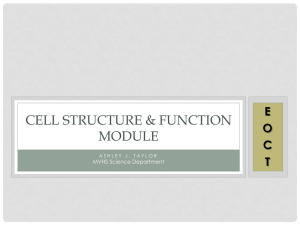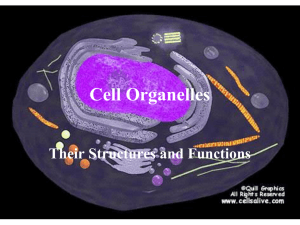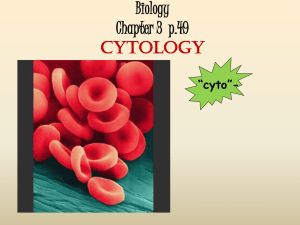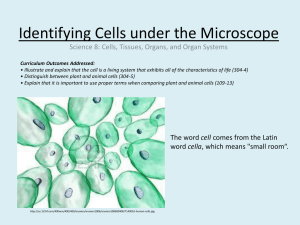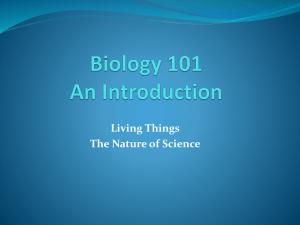Cells: The Basic Unit of Life
advertisement
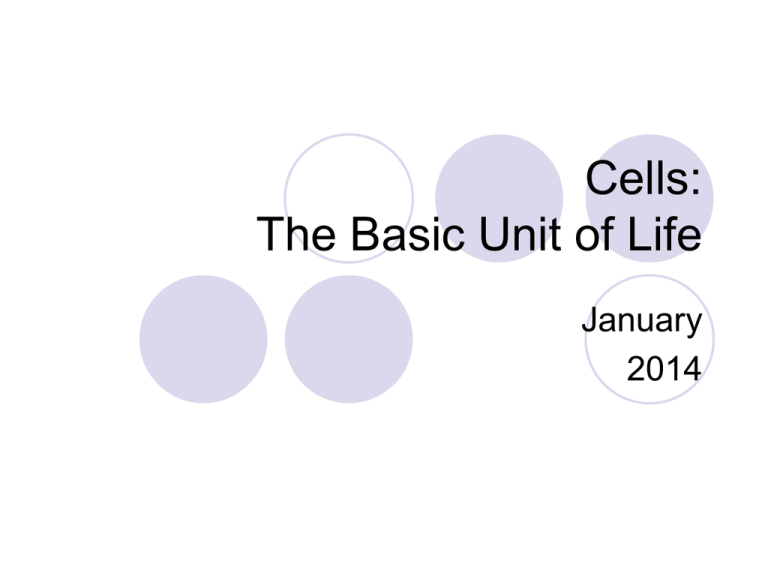
Cells: The Basic Unit of Life January 2014 Vocabulary 1. tissue-a group of cells that work together to perform a specific job 2. organ- a group of 2 or more tissues working together to perform a specific job 3. organ system- organs working together in a group to perform specific jobs 4. organism-anything that can live on its own 5. unicellular- organism that is a single cell Vocabulary continued 6. multicellar- organism that is made of many cells 7. population- group of organisms that are the same kind and that live in the same area 8. community- 2 or more different populations living in the same area 9. ecosystem- the community and all nonliving things that affect it Vocabulary continued 10. cell membrane- acts as a barrier between the inside of the cell and the cell’s environment 11. organelles-structures in a cell that allow it to live, grow, and reproduce 12. cytoplasm-fluid in a cell that contains the organelles Vocabulary continued 13. nucleus- holds the cells DNA and is the control center for the cell 14.prokayotic- cells that do not have a nucleus 15. eukaryotic- cells with a nucleus 16. bacteria- singe celled organisms without a nucleus The discovery of cells 1. In 1665, a British scientist named Robert Hooke discovered cells 2. He named them cells, which means “little rooms” In Latin Cell Theory - The foundation of biology Cell Theory 1. All living things are made of cells 2. Cells are the basic structure and function of all living things 3. All cells come from existing cells Video Compare and Contrast Eukaryotes and Prokaryotes Prokaryotic cell 1. no nucleus 2. no membrane-covered organelles 3. circular DNA 4. Bacteria Eukayotic cell 1. nucleus 2. membrane-covered organelles 3. linear DNA 4. All other cells Cell organelles 1. cell membrane- surrounds the cell, keeps the cytoplasm inside and allows nutrients to enter the cell and waste products to exit the cell Found in plant and animal cell It’s function reminds me of ………. Cell organelles 2. cell wall- made of cellulose, provides strength and support to the cell membrane Found in plant cells It’s function reminds me of ………. Cell organelles 3. nucleus- contains the cell’s DNA and is the control center for the cell Found in plant and animal cell It’s function reminds me of ………. Cell organelles 4. ribosomes- amino acids are hooked together to make proteins Found in plant and animal cells It’s function reminds me of…….. Cell organelles 5. Mitochondria-break down food molecules to make ATP (energy) “power house” Found in plant and animal cells It’s function reminds me of………. Cell organelles 6. chloroplasts-make food using the energy from sunlight Found in plant cells It’s function reminds of ……… Cell organelles 7. endoplasmic reticulum- makes lipids (fats), breaks down drugs, packages up proteins for release from the cell Found in plant and animal cells It’s function reminds me of…… Cell organelles 8. golgi complex- processes and transports materials out of the cell Found in plant and animal cell It’s function reminds me of……. Cell organelles 9. Vacuole-stores water and other materials A large vacuole is found in plant cells, smaller vacuoles are found in animals cells It’s function reminds me of…….. Cell organelles 10. lysosomes- digest food particles, wastes, cell parts and foreign invaders Found in plant and animal cells It’s function reminds me of…… Cell Organelles 11. CytoplasmFluid that holds the organelles Found in plant and animal cells It’s function reminds me of……
